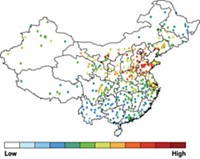Advertisement
Grab your lab coat. Let's get started
Welcome!
Welcome!
Create an account below to get 6 C&EN articles per month, receive newsletters and more - all free.
It seems this is your first time logging in online. Please enter the following information to continue.
As an ACS member you automatically get access to this site. All we need is few more details to create your reading experience.
Not you? Sign in with a different account.
Not you? Sign in with a different account.
ERROR 1
ERROR 1
ERROR 2
ERROR 2
ERROR 2
ERROR 2
ERROR 2
Password and Confirm password must match.
If you have an ACS member number, please enter it here so we can link this account to your membership. (optional)
ERROR 2
ACS values your privacy. By submitting your information, you are gaining access to C&EN and subscribing to our weekly newsletter. We use the information you provide to make your reading experience better, and we will never sell your data to third party members.
Environment
Mechanism behind London’s ‘killer fog’ of ’52 identified
Chemistry points to the need to curb nitrogen dioxide and ammonia emissions to prevent severe haze events in China
by Jyllian Kemsley
November 21, 2016
| A version of this story appeared in
Volume 94, Issue 46
London’s “Great Smog” of 1952 killed thousands and led the U.K. to enact clean air laws in subsequent years. Severe haze events still present a serious air-quality problem, particularly in China, but even after all these years the chemistry behind how airborne chemicals and particulates combine to produce such haze remains hazy. A key component is aqueous oxidation of sulfur dioxide to sulfate by nitrogen dioxide, says an international team of researchers led by Gehui Wang of the Chinese Academy of Sciences, Renyi Zhang of Texas A&M University, and Mario J. Molina of the University of California, San Diego (Proc. Natl. Acad. Sci. USA 2016, DOI: 10.1073/pnas.1616540113). Sulfur dioxide and nitrogen dioxide are coproduced during combustion of coal and other fuels. Through lab experiments and field studies, the researchers found significant SO2 oxidation under two conditions: when cloud droplets are available, as in London, or on fine aerosol particles when there is high humidity and enough ammonia around to neutralize the pH, as is the case in haze events in China. The results suggest that NO2 and NH3 emissions must be controlled along with SO2 to reduce severe haze.





Join the conversation
Contact the reporter
Submit a Letter to the Editor for publication
Engage with us on Twitter